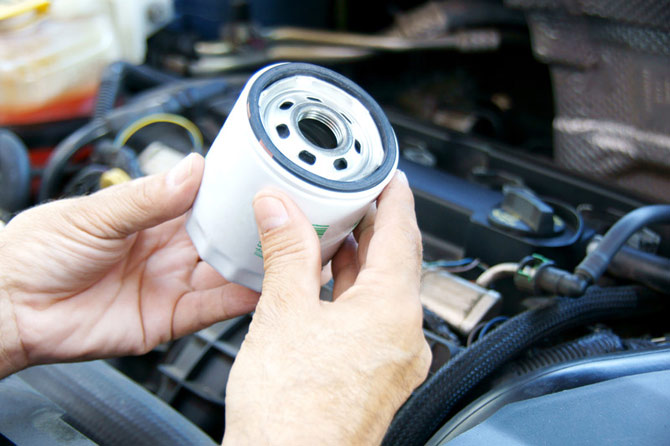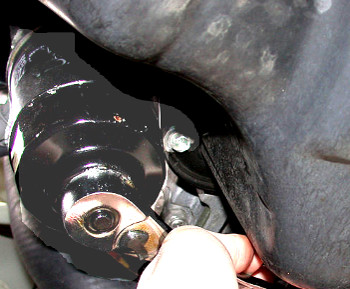
Importance Of An Oil And Filter Change
Importance Of An Oil And Filter Change
Why getting regular oil and filter changes can extend the life of your car’s engine
Most consumers realize that the basic function of an oil filter is to remove contaminants, dirt particles and debris from engine oil, transmission oil, lubricating oil, or hydraulic oil. Oil filters have their main use in internal-combustion engines. While it can’t be understated that the quality of the oil used plays a very important part in keeping your engine from excessive wear, the oil filter plays an equal part in this function.
To illustrate this Paul took 2 used oil filters that fit the same car, one is a good quality the other a cheap filter. By cutting each filter in half and separating the filtering material you can see the important role the good filter plays in protecting your engine from wear.
An important note is that it used to be recommended years ago to change your engine oil every 3000 miles. Today with modern technology and newer synthetic oils, many push that past that mar. They sometimes are even doubling that figure up to 6000 miles before a change is needed. However, you can use the best oil on the market but if you buy the cheapest filter you’re wasting your money. It’s the dirt particles that are the cause of most problems and if you buy a cheap oil filter then it simply doesn’t filter out the contaminants to the degree a higher quality filter will, and especially over an extended time.

So, what are you really accomplishing in trying to save on your oil and filter, nothing, and you could really be costing yourself later. What’s the difference between a good filter and a cheap one, in most cases no more than $3 or $4. So, ask yourself, is it worth it? A good high-quality oil filter does several things. Number one, it filters out more debris, and number two, it lasts longer. Another good idea is to check and see if there are different size filters that fit your vehicle as a larger filter will filter out more dirt and it gets clogged up less so it last even longer.
In the photo, you see 2 oil filters that both fit the same automobile. The filter on the left is the better grade and the one on the right is a cheap grade filter. Paul cut these 2 filters in half to illustrate the differences. The higher quality filter has more filtering material and filters out more debris and contaminants than the cheaper filter.
The time frame you choose to change your oil should be adhered to a closely as possible. Delaying or especially skipping those periods can cause a whole bunch of problems for your automobile. That’s one reason why you’ll see most shops place a reminder mileage sticker in your window when you have your oil and filter changed. That brings up another must, always change your filter when you change your oil. It’s not only just the normal debris that can affect your filter, but your driving habits or conditions as well. Cold starting of your engine and short trips in cold weather also tend to add to contaminants because the oil hasn’t heated up to the degree that it burns off moisture and other particles as with normal weather and driving.
A very important thing to avoid is letting your filter get clogged up or restricting the oil flow to your engine. In this case the oil can bypass the filter all together to satisfy the engine oil pressure requirements, and that’s not something you want to allow.
Now that we’ve discussed the basics here’s a little information for all consumers to make note as understanding the importance of your oil filter will help you pay closer attention to the maintenance part.
Bypass and full-flow – a Brief Background
While we’re certainly not trying to turn our customers or site visitors into auto repair mechanics, a basic background here will certainly help you to keep your car running smoother and longer and help you avoid costly and unnecessary repairs.
Early automobile engines did not use oil filters but that meant that very frequent oil changes were required. The first oil filters were simple, generally consisting of a screen placed at the oil pump intake. On November 27, 1923, American inventors George Greenhalgh and Ernest Sweetland filed U.S. Patent #1721250 for an automotive oil filter and called it the Purolator, a portmanteau of “pure oil later”. The Purolator oil filter, which most of you reading this have most likely heard of, was the first oil filter invented for the automobile and revolutionized the filtration industry and is still in production today.
This original invention was a bypass filter. Most of the oil flowed directly from the oil pan to the engine’s working parts, and a smaller proportion of the oil was sent through the filter via a second flow path in parallel with the first. The oil was thus filtered over time. But as mentioned before, filter bypass may occur if the filter is clogged or the oil is thickened by cold weather and along with debris build up due to installing a cheaper filter. If there is too long a period between oil and filter changes can cause premature wear of moving parts so regular maintenance is important.
The basic design as you see in the photos show that the mechanical designs employ an element made of bulk material or pleated filter paper to entrap and sequester suspended contaminants. As material builds up on (or in) the filtration medium, oil flow is progressively restricted. This requires periodic replacement of the filter.
Remember, as your car sits for days, the oil is affected by normal gravity and begins to drip down back into the pan, leaving all the moving and normally protected areas with a very thin layer of oil protection. Many automobiles have anti-drain valves or ‘dams’ so to speak, to help prevent such a situation and keep as much oil as possible in the upper regions of your engine until started again. What this does is help protect your moving parts on initial startup from suffering from excessive wear.
The higher quality oil filters are designed with increased capacity and higher efficiency ratings to filter more contaminates over a longer period of time between changes without having to go into bypass mode.
 Some filter manufacturers may have specific categories or types of filters designed to last longer than 6,000 miles, we recommend you ‘Don’t’ do it as an oil change with the best oil and best or high-grade filter may cost you $10-15 more than a regular oil change and you may be doing it in 3000-4000 miles instead of holding out to the 6000 mile mark. You’re stepping over a dollar to pick up a dime as you’re investing a little to save a a lot.
Some filter manufacturers may have specific categories or types of filters designed to last longer than 6,000 miles, we recommend you ‘Don’t’ do it as an oil change with the best oil and best or high-grade filter may cost you $10-15 more than a regular oil change and you may be doing it in 3000-4000 miles instead of holding out to the 6000 mile mark. You’re stepping over a dollar to pick up a dime as you’re investing a little to save a a lot.
Remember, when it comes to selling your car, keeping a record of all your automobiles maintenance and repairs only increases the value you can ask for your car because it shows the condition over a period of time to the potential buyer. And if you intend on keeping it, you can rest assured you’ll be getting far more miles out of your auto’s engine than those who stretch out their maintenance and oil and filter changes to the maximum and spend as little as possible in doing it.



